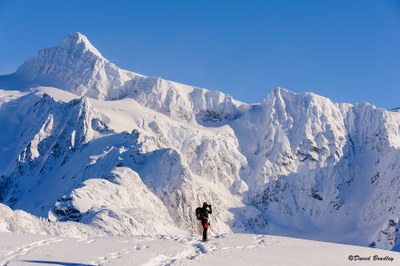
Snowshoeing Course
Intermediate Snowshoeing Course
Intermediate Snowshoeing Course - Seattle
- Wed, Jan 22, 2020 - Thu, Apr 30, 2020
- Committee: Seattle Snowshoeing Committee
- Members: $85.00
- Availability: FULL, 1 on waitlist (30 capacity)
- Cancellation & Refund Policy
The Intermediate Snowshoeing Course is designed for adventurers who want to gain the skills and experience to handle more challenging snowshoe routes and terrain. Intermediate and Strenuous trips are, in many cases, non-technical mountain-climbing routes with mountain peaks for destinations. The course will cover material needed to survive in backcountry terrain, including introductory avalanche awareness and response, incident response, emergency shelters, self-belay and self-arrest skills. This course is open to graduates of Basic Snowshoeing and also to graduates from Alpine Scrambling or Basic Climbing.
Financial Assistance
The Mountaineers strives to serve everyone, regardless of ability to pay. We are committed to providing access to outdoor recreation, education and conservation opportunities for all members and youth in the communities we serve. If you would like to take this course and are experiencing financial hardship or limitations, please apply for financial assistance. Here is more information about the Mountaineers Financial Assistance Program.
What to Expect in the Course
This course includes the lecture on 1/22 and two field trips on 2/1 and 2/8. Please note that you must attend the lecture before you can participate in the field trips.
Current students and graduates of Intermediate Snowshoeing will be eligible to participate in Intermediate and Strenuous snowshoe trips after successful completion of the field trips.
You must be fit for the more physically demanding courses like Snowshoeing, Alpine Scrambling or Basic Climbing. Try hiking up Mt. Si (8 miles round-trip; 3,550 ft. elevation gain) and see how you do. If you can get to the top of Mt. Si (to the view points in the haystack basin) in 2½ hours or less (barring icy conditions), you are probably in adequate condition for this course.
An ice axe is required for this course. Guidelines on how to choose a general ice axe (not for technical ice climbing) will be provided to you at the lecture, or students can go to a local outdoor retailer and request sizing assistance.
Students have three years to complete their requirements for graduation, which are:
- Attendance at the lecture and satisfactory performance at both field trips
- Wilderness Navigation
- Stewardship
- Successful completion of 3 snowshoe trips, at least two of which must be Intermediate or Strenuous.
Although not required, please consider taking some of the Avalanche Safety courses: Avalanche Awareness (free), AIARE Avalanche Rescue or AIARE 1.
For additional questions, please email Seattle Snowshoe Courses Subcomittee.
Badges you will earn:
This course has no scheduled activities.
CLOTHING & EQUIPMENT
- Pack (large enough for all winter gear)
- Snowshoes
- Sturdy, lug-soled, waterproofed boots
- Ice axe (for general mountaineering; properly sized)
- Helmet (for field trip only – to practice ice axe arrest; not typically used on regular trips)
- Clothing Layers (no cotton)
Inner Layer:
- Wicking Liner socks, 2 pairs (one pair worn, other pair carried)
- Synthetic Warm Underwear, top & bottom, 2 sets (one set worn, other set carried)
- Liner gloves, (+ extra set in pack)
Insulating Layer:
- Outer socks, 2 pairs (one pair worn, other pair carried)
- Pants, synthetic fleece or wool. Soft-shell or sturdy hiking pants suffice for many.
- Shirt or sweater, synthetic fleece or wool
- Mittens or gloves, 2 pairs (one pair worn, other pair carried)
Protective Layer:
- Rain parka with hood – waterproof & breathable preferred to avoid trapped moisture.
- Rain pants – waterproof & breathable preferred to avoid trapped moisture.
- Long gaiters. Be sure they fit your boots correctly so that snow doesn’t crawl underneath. GoreTex or insulated gaiters are not necessary.
- Hats (one for warmth; one for sun protection)
- Wind jacket (which may be your rain parka). A fleece or wind stopper vest is also handy if it is warm.
- Scarf or neck gaiter if you tend to get cold easily.
Additional Recommended Equipment/Supplies for the Field Trip:
- Ski Poles/Trekking poles with baskets (highly recommended)
- Foam sit pad
- Hand and toe warmers
- Toilet paper, sealable plastic bags, and hand sanitizer
- Pack cover
- Dry clothes and shoes in your car for the trip home
- Garbage bags in your car for wet gear
- Camera and extra batteries, if desired
You must register for this course to see course materials.

 Intermediate Snowshoeing Course
Intermediate Snowshoeing Course
 Snow Travel
Snow Travel
 Basic Navigation Course
Basic Navigation Course
 Stewardship Credit
Stewardship Credit